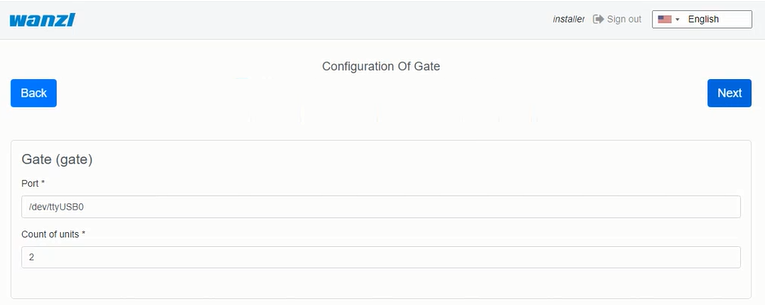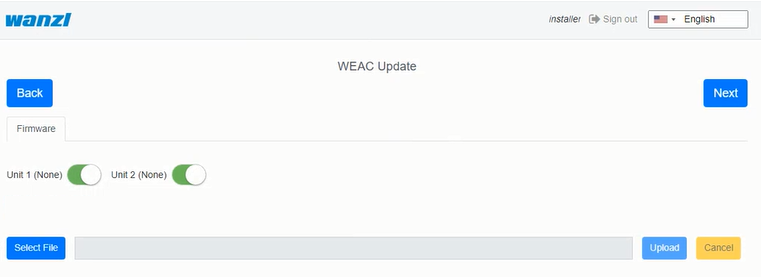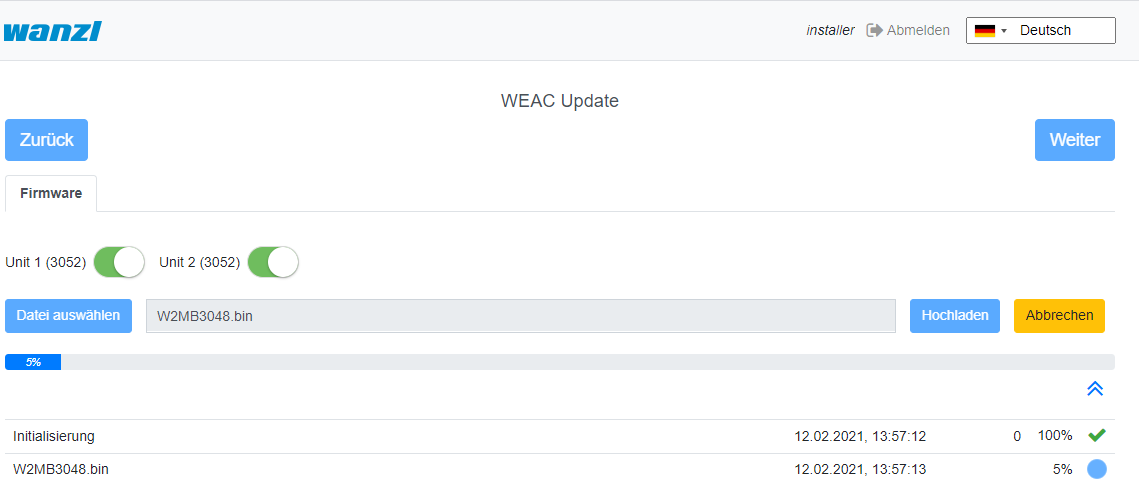Gate ~ FMCU ~ Benutzerhandbuch/en: Unterschied zwischen den Versionen
← Gate ~ FMCU ~ Benutzerhandbuch/en
Writer (Diskussion | Beiträge) (Markierung: 2017-Quelltext-Bearbeitung) |
(→System) (Markierung: 2017-Quelltext-Bearbeitung) |
Inhaltsverzeichnis
- 1 Allgemein Introduction
-
2 Technische Information Initial Configuration
- 2.1 Konfiguration
3 Bedienungsanleitung
- 3.1 Konfiguration der Schwenktüren 3.2 Konfiguration des
- 3 Operation Manual -Schlüssel hinterlegen
- Softwareupdates
- Kundenrolle
- Standardbelegung Anschlussboard
- Alarmdefinition
- Signale
- 4 Technischer Hintergrund
- 5 Funktionen 6 Tipps zum Arbeiten
- 4 Technical Background
- 5 Functions
- 6 Tips for Working
- 7 Verwandte Themen
AllgemeinIntroduction[Bearbeiten | Quelltext bearbeiten]
Das Dokument beschreibt die Funktionen und die Konfigurationsmöglichkeiten der Software The document describes the functions and configuration options of the software Facility Management Control Unit.
Die The Facility Management Control Unit ist eine Software zur Steuerung von Zutrittskontrollen. Diese Komponenten können in einem abgeschlossenen Bereich wie einem Sport- oder Unterhaltungszentrum, einer Zone auf einem Flughafen, in Universitäten oder in Sicherheitsbereichen eingesetzt werden. Die Hauptkomponenten der Softwarelösung umfassen:
- Eine automatisierte Durchgangskontrolle mit zweigeteilter Tür- und Signalbeleuchtung
- Barcode- (oder / und RFID-) Scanner, die Identifikationsdaten vom Ticket oder der Karte des Kunden lesen
- Tracking-Kamera, die den Durchgangsweg der Kunden beobachten
- Infobildschirme, die dem Kunden Informationen zum Ein- und Ausgang anzeigen
- Ein oder mehrere externe Lautsprecher
- Ein oder mehrere zusätzliche Monitore mit Inhalten, die auf die Kundenbedürfnisse zugeschnitten sind
Die Hauptmerkmale beinhalten:
- Öffnen der Zutrittskontrolle bei erfolgreicher Validierung des Ticktes
-
Interaktion mit dem Kunden als Reaktion verschiedener Ereignisse durch:
- Lichteffekte
- Sprachansagen über interne oder externe Lautsprecher
- Akustische Bestätigung des Leseprozesses von Barcode-Scannern
- Visuelle Inhalte, die auf einem Infobildschirm angezeigt werden
- Sicheres Öffnen und Schließen der Schwenktüren durch Überwachung des Durchgangsbereichs
Unterstützte Betriebsarten:
- Normal
- Service
- Feueralarm
- Notfall
Ticketeintrittsvarianten:
- Einzeleintrittskarte mit Schließen der Zutrittskontrolle nach dem Durchgang einer Person
- Mehrfacheintrittskarte mit Daueröffnung der Zutrittskontrolle
- einstellbare Zeitintervalle
- Berücksichtigung zusätzlicher Bedingungen über potentialfreie Kontakte
Technische Information[Bearbeiten | Quelltext bearbeiten]
Konfiguration[Bearbeiten | Quelltext bearbeiten]
Schritt 1
Nachdem die Software heruntergeladen und auf die eMMC Karte nach dem dokumentierten Verfahren übertragen worden ist, siehe herzu auch Galaxy Gate Inbetriebnahme, erscheint nach dem ersten Starten der Anmeldebildschirm. Nachdem man sich mit dem Benutzer Installer angemeldet hat, wird der Assistent mit der Definition der IP-Konfiguration gestartet.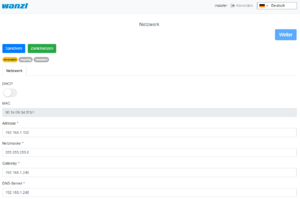
is software for access control management. It can be used in an enclosed area such as a sports or entertainment center, an airport zone, universities or security areas. The main components of the software solution are:
- An automated passage control with two-part door and signal lighting
- Barcode (or/and RFID) scanners that read identification data from the customer's ticket or card
- Tracking cameras observing the passage of customers
- Info screens showing inbound and outbound information to the customer
- One or more external speakers
- One or more additional monitors with content tailored to customer needs
The main features are:
- Opening access control upon successful ticket validation
-
Interaction with customer in response to various events through:
- Light effects
- Voice prompts through internal or external speakers
- Acoustic confirmation of the reading process from barcode scanners
- Visual content displayed on an info screen
- Safe opening and closing of the swing doors by monitoring the passage area
Supported operating modes:
- Normal
- Service
- Fire alarm
- Emergency
The variants of Entry Tickets:
- Single entry ticket with closing of access control after passage of one person
- Multiple entry ticket with permanent access control
- Adjustable time intervals
- Consideration of additional conditions about potential-free contacts
Initial Configuration[Bearbeiten | Quelltext bearbeiten]
After the software has been downloaded and transferred to the eMMC card according to the documented procedure, see also here Galaxy Gate Inbetriebnahme/en, the login screen appears after the first start. After logging in with the user Installer, configuration wizard will be started.
Network[Bearbeiten | Quelltext bearbeiten]
First step is the network settings configuring 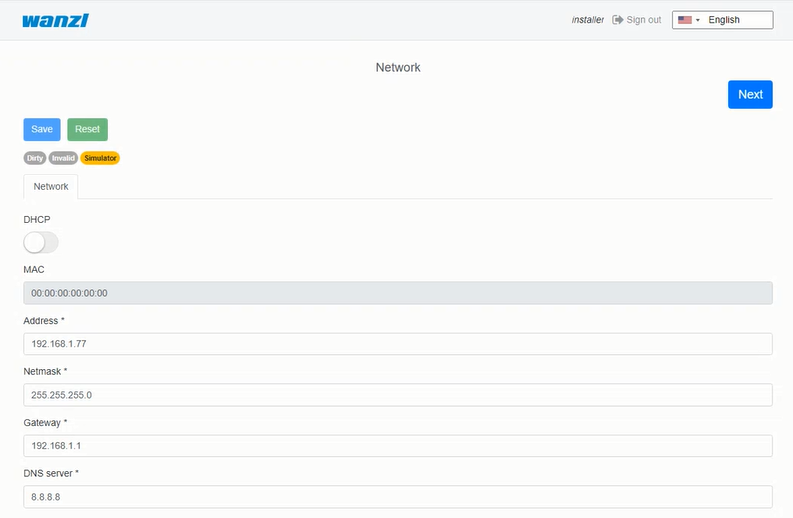
| Parameter | Description | Default Value |
|---|---|---|
| Address | IP-Address of access control | 192.168.1.100 |
| Maske Mask Netzwerkmaske | Network-Mask | 255.255.255.0 |
| Gateway | Gateway-Adresse Address | 192.168.1.1 |
| DNS-Server | DNS-Server für die Namensauflösung for name resolution | 192.168.1.1 |
FMCU Configuration[Bearbeiten | Quelltext bearbeiten]
Next step is selecting FMCU Configuration 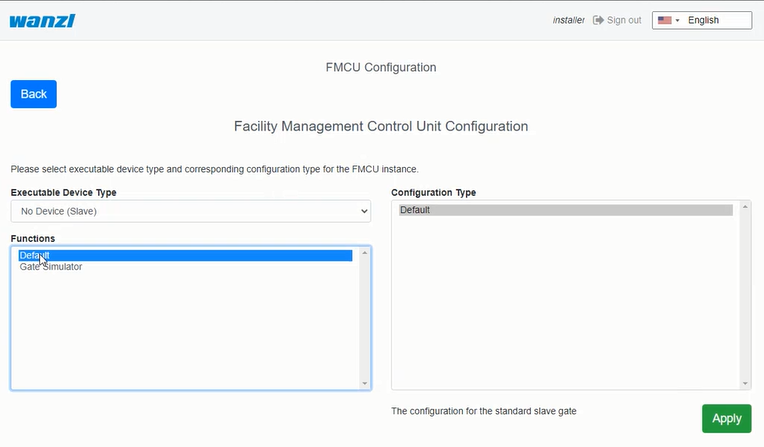
Als Typ kann man im Assistenten grundsätzlich diese Auswahl vornehmen.
As a type, you can basically make this selection in the assistant.
| Selection | Description |
|---|---|
| No Device Slave | Slave Unit (StandardauswahlDefault Selection) |
| Galaxy Gate (Modbus Serial) | Master-Unit mit serieller Verbindung zu Slave-Unit |
| Galaxy Gate (Modbus TCP) | Master-Unit mit Netzwerkverbindung zu with network connection to Slave-Unit |
| Galaxy Port (Modbus Serial) | Unit mit serieller Verbindung zu with serial connection to Slave-Unit |
| Galaxy Port (Modbus TCP) | Unit mit Netzwerkverbindung zu with network connection to Slave-Unit |
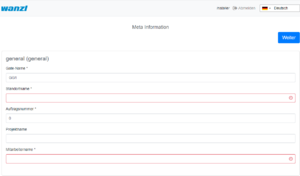 Nachdem die Eingabefelder ausgefüllt worden sind, kann man auf Weiter klicken, um die nächste Seite des Assistenten zu erreichen.
Nachdem die Eingabefelder ausgefüllt worden sind, kann man auf Weiter klicken, um die nächste Seite des Assistenten zu erreichen.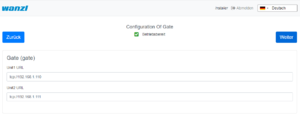 Auf der nächsten Seite des Assistenten wird die aktuelle WEAC-Firmware angezeigt. Bei Bedarf kann man ein Down oder Upgrade der Firmware durchführen.
Auf der nächsten Seite des Assistenten wird die aktuelle WEAC-Firmware angezeigt. Bei Bedarf kann man ein Down oder Upgrade der Firmware durchführen.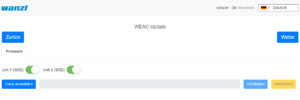 Die Version der Firmware für jede Unit wird als Label neben dem Aktivierungsbutton aufgeführt. Während des Aktualisierungsvorganges werden die Navigationsmöglichkeiten deaktiviert. Der Aktualisierungsprozess dauert ca. 3 Minuten für beide Units.
Die Version der Firmware für jede Unit wird als Label neben dem Aktivierungsbutton aufgeführt. Während des Aktualisierungsvorganges werden die Navigationsmöglichkeiten deaktiviert. Der Aktualisierungsprozess dauert ca. 3 Minuten für beide Units.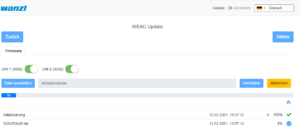 Nach dem Prüfen der WEAC-Firmware werden die Schwenktüren konfiguriert. Dabei wird automatisch geprüft, ob die Mindestvoraussetzungen bzgl. der Firmware erfüllt werden. In der Oberfläche wird man darüber informiert, wenn zunächst die Firmware aktualisiert werden muss.
Nach dem Prüfen der WEAC-Firmware werden die Schwenktüren konfiguriert. Dabei wird automatisch geprüft, ob die Mindestvoraussetzungen bzgl. der Firmware erfüllt werden. In der Oberfläche wird man darüber informiert, wenn zunächst die Firmware aktualisiert werden muss.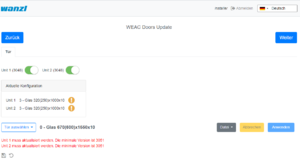 Wenn die Voraussetzungen erfüllt werden, kann man die Schwenktüren auswählen und auf das Gate anwenden.
Wenn die Voraussetzungen erfüllt werden, kann man die Schwenktüren auswählen und auf das Gate anwenden.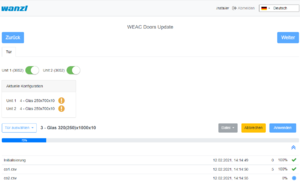 Im nächsten Schritt wird die Konfiguration des LED-Player für beide Units (Master und Slave) durchgeführt. Bei Bedarf kann man die Parameter anpassen. Wenn der Zustand betriebsbereit angezeigt wird, sind keine Modifikationen notwendig.
Im nächsten Schritt wird die Konfiguration des LED-Player für beide Units (Master und Slave) durchgeführt. Bei Bedarf kann man die Parameter anpassen. Wenn der Zustand betriebsbereit angezeigt wird, sind keine Modifikationen notwendig.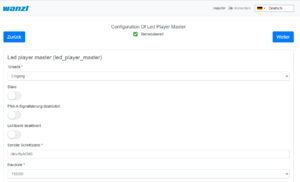 Auf der letzten Seite des Assistenten wird noch einmal die aktuelle Firmware des LED-Player dargestellt. Optional kann man die Konfiguration mit einem Neustart beenden. Jedoch ist dies nur dann erforderlich, wenn sich IP-Adressen oder Schnittstelleinformationen geändert haben.
Auf der letzten Seite des Assistenten wird noch einmal die aktuelle Firmware des LED-Player dargestellt. Optional kann man die Konfiguration mit einem Neustart beenden. Jedoch ist dies nur dann erforderlich, wenn sich IP-Adressen oder Schnittstelleinformationen geändert haben.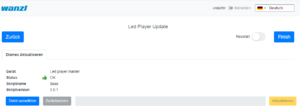 Nachdem man auf Finish geklickt hat, kann man sich jetzt mit einem bekannten Anmeldeinformationen erneut anmelden und mit dem Galaxy Gate arbeiten. Wenn man sich erneut mit dem Benutzer Installer anmeldet, erhält man eine grafische Übersicht, kann sich über den Status der Zutrittskontrolle informieren und kann bei Bedarf Aktualisierungen durchführen. Damit ist die Einrichtung der Zutrittskontrolle abgeschlossen.
Nachdem man auf Finish geklickt hat, kann man sich jetzt mit einem bekannten Anmeldeinformationen erneut anmelden und mit dem Galaxy Gate arbeiten. Wenn man sich erneut mit dem Benutzer Installer anmeldet, erhält man eine grafische Übersicht, kann sich über den Status der Zutrittskontrolle informieren und kann bei Bedarf Aktualisierungen durchführen. Damit ist die Einrichtung der Zutrittskontrolle abgeschlossen.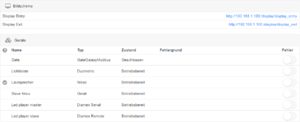 Man kann sich nun mit einem Service-Account anmelden und weitere Tests durchführen.
Man kann sich nun mit einem Service-Account anmelden und weitere Tests durchführen.
Bedienungsanleitung[Bearbeiten | Quelltext bearbeiten]
Konfiguration der Schwenktüren[Bearbeiten | Quelltext bearbeiten] Die Schwenktüren können unterschiedliche Abmaße besitzen, Je nach Breite und Höhe ergeben sich hierdurch andere Sollparameter für einen optimalen Kurvendurchlauf.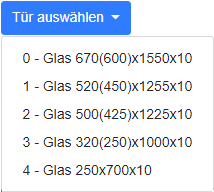 Nachdem ein Typ ausgewählt worden ist, kann man alle Parameter entsprechend den Bedürfnissen in der Oberfläche anpassen, bevor diese dann über den Button Anwenden in der Konfiguration auf der Zutrittskontrolle aktiviert werden. Wenn man einzelne Werte in der Anzeige ändert, müssen die Einstellungen zunächst gespeichert werden. Dazu klick man links in der Oberfläche über der Dateiliste auf das Diskettensymbol.
Nachdem ein Typ ausgewählt worden ist, kann man alle Parameter entsprechend den Bedürfnissen in der Oberfläche anpassen, bevor diese dann über den Button Anwenden in der Konfiguration auf der Zutrittskontrolle aktiviert werden. Wenn man einzelne Werte in der Anzeige ändert, müssen die Einstellungen zunächst gespeichert werden. Dazu klick man links in der Oberfläche über der Dateiliste auf das Diskettensymbol.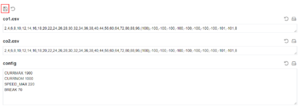 Nachdem die Veränderungen gespeichert worden sind, kann man diese dann über den Button Anwenden aktivieren. Konfiguration des
Nachdem die Veränderungen gespeichert worden sind, kann man diese dann über den Button Anwenden aktivieren. Konfiguration des
| Funktion Function | Beschreibung Description |
|---|---|
| AEA | Konfiguration für Configuration for Boarding Gates |
| Sofortige Schließung | Schließen der Schwenkarme ohne Schwenkbereichsüberwachung |
| Mehrfachöffnung | Schwenkarme bleiben offen, wenn mehrere Eingangssignale anliegen |
| Personenschutz | Schließen der Schwenkarme mit Schwenkbereichsüberwachung |
| Einmalöffnung | Einzeldurchgang auch bei Anliegen von mehreren Einangssignalen |
| Rollkoffer | Unterstützung von Rollkoffer ohne Alarm |
| Rollstuhl | Unterstützung von Rollstuhl ohne Alarm |
| Konfigurationstyp | Beschreibung |
|---|---|
| AEA | Konfiguration für Boarding Gates |
| Einmalöffnung Personenschutz | Schließen der Schwenkarme mit Schwenkbereichsüberwachung |
| Einmalöffnung sofortige Schließung | Schließen der Schwenkarme ohne Schwenkbereichsüberwachung |
| Einmalöffnung Rollkoffer | Einzeldurchgang mit Rollkoffer auch bei Anliegen von mehreren Eingangssignalen |
| Einmalöffnung Rollstuhl | Einzeldurchgang mit Rollstuhl auch bei Anliegen von mehreren Eingangssignalen |
| Mehrfachöffnung Personenschutz | Schließen der Schwenkarme mit Schwenkbereichsüberwachung |
| Mehrfachöffnung sofortige Schließung | Schließen der Schwenkarme ohne Schwenkbereichsüberwachung |
| Mehrfachöffnung Rollkoffer | Schwenkarme bleiben offen, wenn mehrere Personen mit Rollkoffer durchgehen |
| Mehrfachöffnung Rollstuhl | Schwenkarme bleiben offen, wenn mehrere Personen mit Rollkoffer durchgehen |
| Immediate Closure | Closing the swivel arms without swivel range monitoring |
| Multiple Opening | Swivel arms remain open when multiple input signals are present |
| Personal Protection | Closing the swivel arms with swivel area monitoring |
| One-time opening | Single pass even when several input signals are present |
| Trolley Case | Support of trolley case without alarm |
| Wheelchair | Assistance from wheelchair without alarm |
| Configuration Type | Description |
|---|---|
| AEA | Configuration for Boarding Gates |
| One-time opening Personal Protection | Closing the swivel arms with swivel area monitoring |
| One-time opening Immediate Closure | Closing the swivel arms without swivel range monitoring |
| One-time opening Trolley Case | Single passage with trolley case even when several input signals are present |
| One-time opening Wheelchair | Single passage with a wheelchair even if several input signals are present |
| Multiple opening personal protection | Closing the swivel arms with swivel area monitoring |
| Multiple opening instant closure | Closing the swivel arms with swivel area monitoring |
| Multi-opening trolley case | Swivel arms remain open when several people with wheeled suitcases pass through |
| Multiple opening wheelchair | Swivel arms remain open when several people with wheeled suitcases pass through |
Meta information[Bearbeiten | Quelltext bearbeiten]
Next step is filling meta information about FMCU 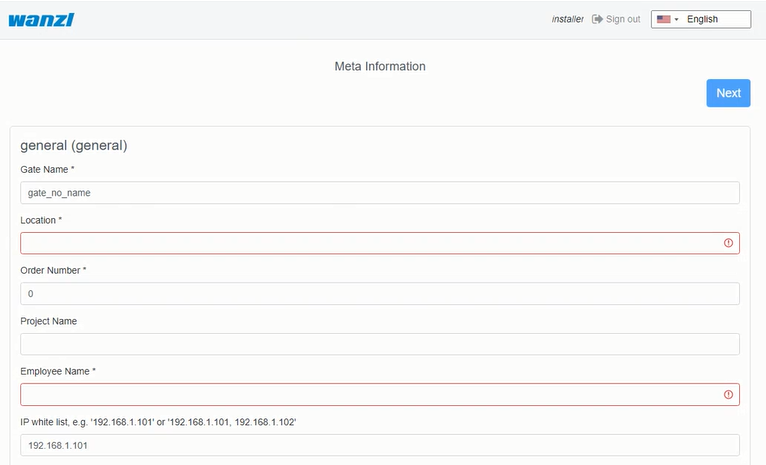
After the input fields have been filled in, you can click on Next to reach the next page of the wizard.
Configuration of Gate[Bearbeiten | Quelltext bearbeiten]
WEAC Firmware Update[Bearbeiten | Quelltext bearbeiten]
The current WEAC firmware is displayed on the next page of the wizard. If necessary, you can down or upgrade the firmware.
The firmware version for each unit is listed as a label next to the activation button. The navigation options are deactivated during the update process. The update process takes about 3 minutes for both units.
After checking the WEAC firmware, the swing doors are configured. It is automatically checked whether the minimum requirements regarding the firmware are met. You will be informed on the surface if the firmware has to be updated first.
No space left on device
| (41 dazwischenliegende Versionen von 3 Benutzern werden nicht angezeigt) | |||
| Zeile 3: | Zeile 3: | ||
{{DISPLAYTITLE:Gate ~ FMCU Galaxy Gate ~ User Guide}} | {{DISPLAYTITLE:Gate ~ FMCU Galaxy Gate ~ User Guide}} | ||
| − | == | + | ==Introduction== |
| − | + | The document describes the functions and configuration options of the software '''F'''acility '''M'''anagement '''C'''ontrol '''U'''nit. | |
| − | + | The Facility Management Control Unit is software for access control management. It can be used in an enclosed area such as a sports or entertainment center, an airport zone, universities or security areas. The main components of the software solution are: | |
| − | * | + | *An automated passage control with two-part door and signal lighting |
| − | *Barcode | + | *Barcode (or/and RFID) scanners that read identification data from the customer's ticket or card |
| − | *Tracking | + | *Tracking cameras observing the passage of customers |
| − | * | + | *Info screens showing inbound and outbound information to the customer |
| − | * | + | *One or more external speakers |
| − | * | + | *One or more additional monitors with content tailored to customer needs |
| − | + | The main features are: | |
| − | * | + | *Opening access control upon successful ticket validation |
| − | * | + | *Interaction with customer in response to various events through: |
| − | ** | + | **Light effects |
| − | ** | + | **Voice prompts through internal or external speakers |
| − | ** | + | **Acoustic confirmation of the reading process from barcode scanners |
| − | ** | + | **Visual content displayed on an info screen |
| − | ** | + | **Safe opening and closing of the swing doors by monitoring the passage area |
| − | + | Supported operating modes: | |
*Normal | *Normal | ||
*Service | *Service | ||
| − | * | + | *Fire alarm |
| − | * | + | *Emergency |
| − | + | The variants of Entry Tickets: | |
| − | * | + | *Single entry ticket with closing of access control after passage of one person |
| − | * | + | *Multiple entry ticket with permanent access control |
| − | * | + | *Adjustable time intervals |
| − | * | + | *Consideration of additional conditions about potential-free contacts |
| − | == | + | ==Initial Configuration== |
| − | + | After the software has been downloaded and transferred to the eMMC card according to the documented procedure, see also here [[Gate ~ FMCU ~ Inbetriebnahme|Galaxy Gate Inbetriebnahme/en]], the login screen appears after the first start. After logging in with the user ''Installer'', configuration wizard will be started. | |
| − | + | ===Network=== | |
| − | + | First step is the network settings configuring | |
| − | + | [[Datei:fmcu-configuring-network-en.png]] | |
{| class="wikitable" | {| class="wikitable" | ||
|+ | |+ | ||
!Parameter | !Parameter | ||
| − | ! | + | !Description |
| − | ! | + | !Default Value |
|- | |- | ||
| − | | | + | |Address |
| − | |IP- | + | |IP-Address of access control |
|192.168.1.100 | |192.168.1.100 | ||
|- | |- | ||
| − | | | + | |Mask |
| − | | | + | |Network-Mask |
|255.255.255.0 | |255.255.255.0 | ||
|- | |- | ||
|Gateway | |Gateway | ||
| − | |Gateway- | + | |Gateway-Address |
|192.168.1.1 | |192.168.1.1 | ||
|- | |- | ||
|DNS-Server | |DNS-Server | ||
| − | |DNS-Server | + | |DNS-Server for name resolution |
|192.168.1.1 | |192.168.1.1 | ||
| − | |}{{ | + | |} |
| + | ===FMCU Configuration=== | ||
| + | Next step is selecting FMCU Configuration | ||
| + | [[Datei:fmcu-configuring-configuration-en.png]] | ||
| + | {{Box_Note|Note Text = The configuration always starts with the "Slave" side of the Galaxy Gate. This selection is preset in the assistant "No Device Slave".}}As a type, you can basically make this selection in the assistant. | ||
{| class="wikitable" | {| class="wikitable" | ||
| − | |+ | + | |+Configuration of the Facility Management Control Unit |
| − | ! | + | !Selection |
| − | ! | + | !Description |
|- | |- | ||
|No Device Slave | |No Device Slave | ||
| − | |Slave Unit ( | + | |Slave Unit (Default Selection) |
|- | |- | ||
|Galaxy Gate (Modbus Serial) | |Galaxy Gate (Modbus Serial) | ||
| Zeile 78: | Zeile 82: | ||
|- | |- | ||
|Galaxy Gate (Modbus TCP) | |Galaxy Gate (Modbus TCP) | ||
| − | |Master-Unit | + | |Master-Unit with network connection to Slave-Unit |
|- | |- | ||
|Galaxy Port (Modbus Serial) | |Galaxy Port (Modbus Serial) | ||
| − | |Unit | + | |Unit with serial connection to Slave-Unit |
|- | |- | ||
|Galaxy Port (Modbus TCP) | |Galaxy Port (Modbus TCP) | ||
| − | |Unit | + | |Unit with network connection to Slave-Unit |
|} | |} | ||
{| class="wikitable" | {| class="wikitable" | ||
| − | |+ | + | |+Functions |
| − | ! | + | !Function |
| − | ! | + | !Description |
|- | |- | ||
|AEA | |AEA | ||
| − | | | + | |Configuration for Boarding Gates |
|- | |- | ||
| − | | | + | |Immediate Closure |
| − | | | + | |Closing the swivel arms without swivel range monitoring |
|- | |- | ||
| − | | | + | |Multiple Opening |
| − | | | + | |Swivel arms remain open when multiple input signals are present |
|- | |- | ||
| − | | | + | |Personal Protection |
| − | | | + | |Closing the swivel arms with swivel area monitoring |
|- | |- | ||
| − | | | + | |One-time opening |
| − | | | + | |Single pass even when several input signals are present |
|- | |- | ||
| − | | | + | |Trolley Case |
| − | | | + | |Support of trolley case without alarm |
|- | |- | ||
| − | | | + | |Wheelchair |
| − | | | + | |Assistance from wheelchair without alarm |
| − | |} | + | |}After the function has been selected, the combination of functions results in corresponding configuration types. The function selection is a filter for the resulting configuration type. |
{| class="wikitable" | {| class="wikitable" | ||
| − | |+ | + | |+Configuration type from combination of functions |
| − | ! | + | !Configuration Type |
| − | ! | + | !Description |
|- | |- | ||
|AEA | |AEA | ||
| − | | | + | |Configuration for Boarding Gates |
|- | |- | ||
| − | | | + | |One-time opening Personal Protection |
| − | | | + | |Closing the swivel arms with swivel area monitoring |
|- | |- | ||
| − | | | + | |One-time opening Immediate Closure |
| − | | | + | |Closing the swivel arms without swivel range monitoring |
|- | |- | ||
| − | | | + | |One-time opening Trolley Case |
| − | | | + | |Single passage with trolley case even when several input signals are present |
|- | |- | ||
| − | | | + | |One-time opening Wheelchair |
| − | | | + | |Single passage with a wheelchair even if several input signals are present |
|- | |- | ||
| − | | | + | |Multiple opening personal protection |
| − | | | + | |Closing the swivel arms with swivel area monitoring |
|- | |- | ||
| − | | | + | |Multiple opening instant closure |
| − | | | + | |Closing the swivel arms with swivel area monitoring |
|- | |- | ||
| − | | | + | |Multi-opening trolley case |
| − | | | + | |Swivel arms remain open when several people with wheeled suitcases pass through |
|- | |- | ||
| − | | | + | |Multiple opening wheelchair |
| − | | | + | |Swivel arms remain open when several people with wheeled suitcases pass through |
| − | |} | + | |}After choosing from the three lists, click on '''Apply''', the application will be restarted, you have to wait for the start-up process to be completed. After logging in again, this screen appears.{{Box_Note|Note Text = If you adjust the IP address in the configuration, you must also align the URL in the browser to the new IP address.}} |
| − | + | ===Meta information=== | |
| − | == | + | Next step is filling meta information about FMCU |
| − | + | [[Datei:fmcu-configuring-meta-information-en.png]] | |
| − | + | ||
| − | + | After the input fields have been filled in, you can click on '''Next''' to reach the next page of the wizard. | |
| − | + | ||
| + | ===Configuration of Gate=== | ||
| + | [[Datei:fmcu-configuring-configuration-of-gate-en.png]] | ||
| + | |||
| + | ===WEAC Firmware Update=== | ||
| + | The current WEAC firmware is displayed on the next page of the wizard. If necessary, you can down or upgrade the firmware. | ||
| + | |||
| + | [[Datei:fmcu-configuring-weac-update-en.png]] | ||
| + | |||
| + | The firmware version for each unit is listed as a label next to the activation button. The navigation options are deactivated during the update process. The update process takes about 3 minutes for both units. | ||
| − | + | [[Datei:image_assistant_04a.png]] | |
| + | |||
| + | After checking the WEAC firmware, the swing doors are configured. It is automatically checked whether the minimum requirements regarding the firmware are met. You will be informed on the surface if the firmware has to be updated first. | ||
| + | |||
| + | |||
| + | ===WEAC Doors Update=== | ||
| + | |||
| + | [[Datei:fmcu-configuring-weac-doors-update-en.png]] | ||
| + | |||
| + | If the requirements are met, you can select the swing doors and apply them to the gate. | ||
| + | |||
| + | [[Datei:image_assistant_step06.png]] | ||
| + | |||
| + | ===Configuring the Led Player=== | ||
| + | The next step is to configure the LED player for both units (Master and Slave) accomplished. If necessary, you can adjust the parameters. If the status is '''ready for use''', no modifications are necessary. | ||
| + | |||
| + | [[Datei:fmcu-configuring-led-player-master-en.png]] | ||
| + | |||
| + | The current firmware of the LED player is shown again on the last page of the assistant. Optionally, you can end the configuration with a restart. However, this is only necessary if IP addresses or interface information have changed. | ||
| + | |||
| + | [[Datei:image_assistant_Step08.png]] | ||
| + | |||
| + | After clicking '''Finish''' you can log in again as certain user and work with the Galaxy Gate. If you log in again as user ''installer'', you get a graphical overview, can find out about the status of the access control and can carry out updates if necessary. | ||
| + | So you complete the setup of the access control. | ||
| + | |||
| + | [[Datei:image_status_en.png]] | ||
| + | |||
| + | You can now log in with a service account and carry out further tests. | ||
| + | ==Operation Manual== | ||
| + | ===Configuration of the Swing Doors=== | ||
| + | The swing doors can have different dimensions. Depending on the width and height, this results in other target parameters for optimal curve passage. | ||
| + | [[Datei:image_glasdoors.png]] | ||
| + | |||
| + | After a type has been selected, all parameters can be adjusted according to the needs in the interface before they are then activated via the button '''Apply''' in the configuration on the access control. If you change individual values in the display, the settings must first be saved. To do this, click on the diskette symbol on the left of the interface above the file list. | ||
| + | |||
| + | [[Datei:image_door_settings.png]] | ||
| + | |||
| + | After the changes have been saved, you can activate them using the Apply button. | ||
| + | |||
| + | ===Configuration of the XOVIS Sensors=== | ||
| + | '''Add XOVIS-Sensor''' | ||
| + | |||
| + | Navigate to "Configuration" -> "Devices" -> "Xovis Cameras" and then click on the "Add" button | ||
| + | |||
| + | [[Datei:add_xovis_device_1.png]] | ||
| + | |||
| + | The following fields are filled in the order shown: | ||
#Name | #Name | ||
#URL | #URL | ||
| − | # | + | #Username |
| − | # | + | #Password |
| + | |||
| + | [[Datei:add_xovis_device_2.png]] | ||
| + | |||
| + | The configuration is saved by clicking the '''Save''' button.{{Box_Note|Note Text = After adding the XOVIS sensor, the '''FMCU''' must be restarted before proceeding with the configuration.}}'''Add XOVIS monitoring area as alarm signal''' | ||
| + | |||
| + | Navigate to "Configuration" -> "Signals" and then click on the "Add" button | ||
| + | |||
| + | [[Datei:add_xovis_alarm_signal_1.png]] | ||
| + | |||
| + | The following fields must be filled in here: | ||
| + | |||
| + | #Select type "XOVIS Sensor" | ||
| + | #Specify the name of the signal (e.g. "XOVIS ALARM") | ||
| + | #Set the minimum number of people in the alarm zone to trigger an alarm (e.g. 2) | ||
| + | #Select the alert type (e.g. "Unauthorized Access") | ||
| + | #Determine a list of alarm zones (e.g. "AlarmZone") | ||
| + | #Select the XOVIS sensor added to. | ||
| + | |||
| + | The configuration is saved by clicking the '''Save''' button. | ||
| + | |||
| + | [[Datei:add_xovis_alarm_signal_2.png]] | ||
| + | |||
| + | '''Add XOVIS counter''' | ||
| − | + | Navigate to "Configuration" -> "Signals" and then click on the "Add" button | |
| − | + | [[Datei:add_xovis_alarm_signal_1.png]] | |
| − | + | The following fields must be filled in here: | |
| − | |||
| − | |||
| − | |||
| − | |||
| − | |||
| − | + | #Select type "XOVIS Sensor". | |
| + | #Specify the name of the signal (e.g. "XOVIS Counter") | ||
| + | #Specify the side of the gate (e.g. "Entrance") | ||
| + | #Set the value "Counter". | ||
| + | #Specify a list of lines(e.g. "EntryLine") | ||
| + | #Select the XOVIS camera that you added earlier. | ||
| − | + | The configuration is saved by clicking the '''Save''' button. | |
| − | + | [[Datei:add_xovis_counter_signal.png]] | |
| − | |||
| − | |||
| − | |||
| − | |||
| − | |||
| − | + | ===Store VPN key=== | |
| − | ===VPN | + | A VPN key is required to use remote maintenance. This key can be requested from maxcrc support (support@maxcrc.de) by specifying the project name (Configuration->General view). |
| − | |||
| − | + | After the key file (*.opvn.conf) is available, you can import via the System->OpenVPN page. The following steps are necessary for this. | |
| − | + | Navigating to the '''System-OpenVPN''' page. | |
| − | === | + | |
| − | + | [[Datei:image_openvpn_step01.png]][[Datei:image_openvpn_step02.png]] | |
| − | === | + | |
| − | + | This file is now specified via the '''Select file''' button in the file selection dialog. Then click on '''Upload'''. When the process has been successfully completed, an info icon will appear next to the start button. This means the file has been uploaded successfully, the OpenVPN client can now be activated by clicking on '''Start'''. | |
| − | === | + | |
| + | [[Datei:image_openvpn_step03.png]] | ||
| + | |||
| + | If the start was successful, the color changes from green to red and the label from start to stop. The status of the OpenVPN client and the IP address for access in the VPN network for this gate are displayed to the right of the info symbol. You can disable remote access by clicking the '''Stop''' button. | ||
| + | |||
| + | ===Update Software=== | ||
| + | If there is no Internet connection, individual package installations can be carried out using the '''System->Update software''' menu. You should have a zip archive with the packages to be installed. It must be ensured that no relative paths are used in the archive. Then you can insert the archive into the input line via '''Select file''' and start the update procedure with '''Upload'''. The progress of update process is displayed: | ||
| + | [[Datei:image_software_update.png]][[Datei:image_update_01.png|375x375px]] | ||
| + | |||
| + | If necessary, the application can be restarted. | ||
| + | |||
| + | ===Customer Role=== | ||
| + | When you log in as user ''client'', a simplified interface appears with "Home", "Status", "Statistics" configuration menus. | ||
| + | [[Datei:image_customer_view_en.png]] | ||
| + | |||
| + | In this view you can administrate the access control, but you cannot make any configuration adjustments. The current statistics are displayed directly on the interface, a complete overview of the accesses can be viewed in the '''Statistics''' tab and exported if required. The current status of the individual access control components can be viewed in the '''Status''' tab. The '''Clearance''' option disables all alarms to make the cleaning staff's job easier. The '''Emergency''' option supports the user in opening the access control immediately. | ||
| + | |||
| + | ===Standard Assignment Connection Board=== | ||
'''Unit 1''' | '''Unit 1''' | ||
{| class="wikitable" | {| class="wikitable" | ||
|+ | |+ | ||
| − | ! | + | !Port |
| − | ! | + | !Function |
| − | ! | + | !Description |
|- | |- | ||
|'''LSU (E1)''' | |'''LSU (E1)''' | ||
|LS Middle | |LS Middle | ||
| − | '' | + | ''Center Light barrier'' |
|NO | |NO | ||
| − | '' | + | ''Normally Open Contact'' |
|- | |- | ||
|'''LSV (E2)''' | |'''LSV (E2)''' | ||
|LS Entry | |LS Entry | ||
| − | '' | + | ''Photocell Input'' |
|NO | |NO | ||
| − | '' | + | ''normally open contact'' |
|- | |- | ||
|'''E3''' | |'''E3''' | ||
|Open Entry | |Open Entry | ||
| − | '' | + | ''Single free entry direction Impuls 0,1-1,0 Sek.'' |
|NO | |NO | ||
| − | '' | + | ''Normally Open Contact'' |
|- | |- | ||
|'''E4''' | |'''E4''' | ||
|Open Exit | |Open Exit | ||
| − | '' | + | ''Single free exit direction Impuls 0,1-1,0 Sek.'' |
|NO | |NO | ||
| − | '' | + | ''normally open contact'' |
|- | |- | ||
|'''LSH (E5)''' | |'''LSH (E5)''' | ||
|NA | |NA | ||
| − | '' | + | ''not connected'' |
| | | | ||
|- | |- | ||
|'''E6''' | |'''E6''' | ||
|State bit 0 | |State bit 0 | ||
| − | '' | + | ''Status bit 0'' |
|NO | |NO | ||
| − | '' | + | ''normally open contact'' |
|- | |- | ||
|'''E7''' | |'''E7''' | ||
|State bit 1 | |State bit 1 | ||
| − | '' | + | ''Status bit 1'' |
|NO | |NO | ||
| − | '' | + | ''normally open contact'' |
|- | |- | ||
|'''E8''' | |'''E8''' | ||
|Fire Alarm | |Fire Alarm | ||
| − | '' | + | ''fire alarm system (BMA)'' |
|NC | |NC | ||
| − | '' | + | ''normally closed contact'' |
|- | |- | ||
|'''E9''' | |'''E9''' | ||
|Open Entry 70% | |Open Entry 70% | ||
| − | ''Einzelfrei 70% | + | ''Einzelfrei 70% Input Direction Impuls 0,1-1,0 Sek.'' |
|NO | |NO | ||
| − | '' | + | ''normally open contact'' |
|- | |- | ||
|'''E10''' | |'''E10''' | ||
|Emergency Open Button | |Emergency Open Button | ||
| − | '' | + | ''emergency button'' |
|NC | |NC | ||
| − | '' | + | ''normally closed contact'' |
|- | |- | ||
|'''A8''' | |'''A8''' | ||
|Entry Confirmation | |Entry Confirmation | ||
| − | '' | + | ''Confirmation of passage entry direction Impuls 0,5 Sek.'' |
| +12 VDC | | +12 VDC | ||
|- | |- | ||
|'''A9''' | |'''A9''' | ||
|Exit Confirmation | |Exit Confirmation | ||
| − | '' | + | ''Confirmation of passage exit direction Impuls 0,5 Sek.'' |
| +12 VDC | | +12 VDC | ||
|}'''Unit 2''' | |}'''Unit 2''' | ||
{| class="wikitable" | {| class="wikitable" | ||
|+ | |+ | ||
| − | ! | + | !Port |
| − | ! | + | !Function |
| − | ! | + | !Description |
|- | |- | ||
|'''LSU (E1)''' | |'''LSU (E1)''' | ||
|NA | |NA | ||
| − | '' | + | ''not connected'' |
| | | | ||
|- | |- | ||
|'''LSV (E2)''' | |'''LSV (E2)''' | ||
|NA | |NA | ||
| − | '' | + | ''not connected'' |
| | | | ||
|- | |- | ||
|'''E3''' | |'''E3''' | ||
|Open Entry | |Open Entry | ||
| − | '' | + | ''Single free entry direction Impuls 0,1-1,0 Sek.'' |
|NO | |NO | ||
| − | '' | + | ''normally open contact'' |
|- | |- | ||
|'''E4''' | |'''E4''' | ||
|Open Exit | |Open Exit | ||
| − | '' | + | ''Single free exit direction Impuls 0,1-1,0 Sek.'' |
|NO | |NO | ||
| − | '' | + | ''normally open contact'' |
|- | |- | ||
|'''LSH (E5)''' | |'''LSH (E5)''' | ||
|LS Exit | |LS Exit | ||
| − | '' | + | ''Photocell exit'' |
|NO | |NO | ||
| − | '' | + | ''normally open contact'' |
|- | |- | ||
|'''E6''' | |'''E6''' | ||
|State bit 2 | |State bit 2 | ||
| − | '' | + | ''Status bit 2'' |
|NO | |NO | ||
| − | '' | + | ''normally open contact'' |
|- | |- | ||
|'''E7''' | |'''E7''' | ||
|State bit 3 | |State bit 3 | ||
| − | '' | + | ''status bit 3'' |
|NO | |NO | ||
| − | '' | + | ''normally open contact'' |
|- | |- | ||
|'''E8''' | |'''E8''' | ||
|Fire Alarm | |Fire Alarm | ||
| − | '' | + | ''fire alarm system (BMA)'' |
|NC | |NC | ||
| − | '' | + | ''normally closed contact'' |
|- | |- | ||
|'''E9''' | |'''E9''' | ||
|Open Exit 70% | |Open Exit 70% | ||
| − | '' | + | ''single free 70% exit direction Impuls 0,1-1,0 Sek.'' |
|NO | |NO | ||
| − | '' | + | ''normally open contact'' |
|- | |- | ||
|'''E10''' | |'''E10''' | ||
|Emergency Open Button | |Emergency Open Button | ||
| − | '' | + | ''emergency button'' |
|NC | |NC | ||
| − | '' | + | ''normally closed contact'' |
|- | |- | ||
|'''A8''' | |'''A8''' | ||
| Zeile 339: | Zeile 432: | ||
|'''A9''' | |'''A9''' | ||
|Gate State Error | |Gate State Error | ||
| − | '' | + | ''error condition Durchgang'' |
| +12 VDC | | +12 VDC | ||
| − | |}'''Status | + | |}'''Status Bits''' |
{| class="wikitable" | {| class="wikitable" | ||
|+ | |+ | ||
| − | ! | + | !Status |
!Unit 1 E6 | !Unit 1 E6 | ||
Bit 0 | Bit 0 | ||
| Zeile 362: | Zeile 455: | ||
|- | |- | ||
|Free Entry | |Free Entry | ||
| − | '' | + | ''Entrance permanently free'' |
!'''1''' | !'''1''' | ||
!'''0''' | !'''0''' | ||
| Zeile 369: | Zeile 462: | ||
|- | |- | ||
|Lock Entry | |Lock Entry | ||
| − | '' | + | ''entrance blocked'' |
!'''0''' | !'''0''' | ||
!'''1''' | !'''1''' | ||
| Zeile 376: | Zeile 469: | ||
|- | |- | ||
|Service Entry | |Service Entry | ||
| − | '' | + | ''Permanently open entry direction'' |
!'''1''' | !'''1''' | ||
!'''1''' | !'''1''' | ||
| Zeile 383: | Zeile 476: | ||
|- | |- | ||
|Free Exit | |Free Exit | ||
| − | '' | + | ''Exit permanently free'' |
!'''0''' | !'''0''' | ||
!'''0''' | !'''0''' | ||
| Zeile 390: | Zeile 483: | ||
|- | |- | ||
|Free Entry/Exit | |Free Entry/Exit | ||
| − | '' | + | ''Input/Output permanently free('''Not implemented''')'' |
!'''1''' | !'''1''' | ||
!'''0''' | !'''0''' | ||
| Zeile 397: | Zeile 490: | ||
|- | |- | ||
|Lock Entry / Free Exit | |Lock Entry / Free Exit | ||
| − | '' | + | ''Entrance blocked / exit permanently free'' |
!'''0''' | !'''0''' | ||
!'''1''' | !'''1''' | ||
| Zeile 410: | Zeile 503: | ||
|- | |- | ||
|Lock Exit | |Lock Exit | ||
| − | '' | + | ''exit blocked'' |
!'''0''' | !'''0''' | ||
!'''0''' | !'''0''' | ||
| Zeile 417: | Zeile 510: | ||
|- | |- | ||
|Free Entry / Lock Exit | |Free Entry / Lock Exit | ||
| − | '' | + | ''Entrance permanently free / exit blocked'' |
!'''1''' | !'''1''' | ||
!'''0''' | !'''0''' | ||
| Zeile 437: | Zeile 530: | ||
|- | |- | ||
|Service Exit | |Service Exit | ||
| − | '' | + | ''Permanently open exit direction'' |
!'''0''' | !'''0''' | ||
!'''0''' | !'''0''' | ||
| Zeile 456: | Zeile 549: | ||
|- | |- | ||
|Self Test | |Self Test | ||
| − | '' | + | ''self test'' |
!'''1''' | !'''1''' | ||
!'''1''' | !'''1''' | ||
| Zeile 462: | Zeile 555: | ||
!'''1''' | !'''1''' | ||
|} | |} | ||
| − | === | + | |
| − | + | ===Alarms Definition=== | |
| + | An alarm is triggered as a follow-up action from signals or other sources (e.g. devices). Navigate to "Configuration" -> "Alarms". | ||
| + | |||
| + | [[Datei:configuration-alarms-en.png]] | ||
| + | |||
| + | To create the alarm click on the "Add" button: | ||
| + | |||
| + | [[Datei:add-alarm-en.png]] | ||
| + | |||
| + | An alarm has several general characteristics: Name, Enabled Status, Priority, Sounds settings, Light settings, etc. | ||
| + | |||
| + | In the table below there are descriptions of existing alarms. | ||
| + | |||
{| class="wikitable" | {| class="wikitable" | ||
|+ | |+ | ||
!Definition | !Definition | ||
| − | ! | + | !Description |
| − | ! | + | !Status |
|- | |- | ||
|Connection Alive | |Connection Alive | ||
| − | | | + | |monitors connection to external application |
| − | | | + | |on/off |
|- | |- | ||
|Connection Lost | |Connection Lost | ||
| − | | | + | |monitors connection to external application |
| − | | | + | |on/off |
|- | |- | ||
|Counter Pass | |Counter Pass | ||
| − | | | + | |is set by anti-rotation protection is activated |
| − | | | + | |on/off |
|- | |- | ||
|Door Break-In | |Door Break-In | ||
| − | | | + | |Door is forcibly moved when closed |
| − | | | + | |on/off |
|- | |- | ||
|Emergency | |Emergency | ||
| − | | | + | |is set if the signals on unit 1 E8 or unit 2 E8 are not active (opener). |
| − | | | + | |on/off |
|- | |- | ||
|Fire Alarm | |Fire Alarm | ||
| − | | | + | |is set if the signals on unit 1 E10 or unit 2 E10 are not active (opener). |
| − | | | + | |on/off |
|- | |- | ||
|Invalid Ticket | |Invalid Ticket | ||
| − | | | + | |is set if ticket validation fails |
|Impuls | |Impuls | ||
|- | |- | ||
|Motionless Object | |Motionless Object | ||
| − | | | + | |is set when an object is in the gate area for more than a defined period of time and closing is prevented by a timeout. |
| − | | | + | |on/off |
|- | |- | ||
|No Alarm | |No Alarm | ||
| − | | | + | |is set if no alarm is defined for signals |
| − | | | + | |on/off |
|- | |- | ||
|Proceed Alarm | |Proceed Alarm | ||
| − | | | + | |analogous to Motionless Object with a different time span and other actions without light indication |
| − | | | + | |on/off |
|- | |- | ||
|Server Alarm | |Server Alarm | ||
| − | | | + | |is triggered in the FMCU server |
| − | | | + | |on/off |
|- | |- | ||
|Tailgating | |Tailgating | ||
| − | | | + | |is set if more than one person is in the gate area |
| − | | | + | |on/off |
|- | |- | ||
|Unauthorized Access | |Unauthorized Access | ||
| − | | | + | |is set if a person is in the gate area when the gate is closed |
| − | | | + | |on/off |
|- | |- | ||
|Valid Ticket | |Valid Ticket | ||
| − | | | + | |is set if the ticket validation was successful (trigger beep) |
|Impuls | |Impuls | ||
|} | |} | ||
| − | |||
| − | |||
| − | [[Datei:FMCU-Signale.png | + | ===Signals=== |
| − | == | + | The information in this section is based on FMCU software v2.3.7 and WEAC version 32.14. |
| − | + | ||
| − | = | + | [[Datei:FMCU-Signale-en.png]] |
| − | + | ||
| + | ===System=== | ||
| + | The information in this section is based on FMCU software v2.6.14. | ||
| + | |||
| + | ====Network==== | ||
| + | |||
| + | [[Datei:FMCU-System-Network-en.png]] | ||
| + | |||
| + | ====Hostname==== | ||
| + | |||
| + | [[Datei:FMCU-System-Hostname-en.png]] | ||
| + | |||
| + | ====Hosts==== | ||
| + | |||
| + | [[Datei:FMCU-System-Hosts.en.png]] | ||
| + | |||
| + | |||
| + | ====CA Certificates==== | ||
| + | |||
| + | [[Datei:FMCU-System-CA-Certificates.en.png]] | ||
| + | |||
| + | ====NTP==== | ||
| + | |||
| + | [[Datei:FMCU-System-NTP.en.png]] | ||
| + | |||
| + | |||
| + | ====nginx==== | ||
| + | |||
| + | [[Datei:FMCU-System-nginx.en.png]] | ||
| + | |||
| + | |||
| + | ====FMCU==== | ||
| + | |||
| + | [[Datei:FMCU-System-FMCU.en.png]] | ||
| + | |||
| + | ===Light Schemas=== | ||
| + | |||
| + | To navigate the section click "Configuration" -> "Light Schemas". Here you can add and/or customize named color schemes. | ||
| + | |||
| + | [[Datei:configuration-light-schemas-en.png]] | ||
| + | |||
| + | Each schema describes the colors and behaviour of FMCU lights elements like enter and exit zones and the door. Existing light schema you can use in settings of '''Gates''' and '''Alarms'''. | ||
| + | |||
| + | Click Add to create light schema or click "pen" in the table to edit existing schema. | ||
| + | |||
| + | [[Datei:add-light-schema-item-en.png]] | ||
| + | |||
| + | Each light schema is described by the fields below | ||
| + | |||
| + | {| class="wikitable" | ||
| + | |+ | ||
| + | !Field | ||
| + | !Description | ||
| + | |- | ||
| + | |Name | ||
| + | |Name of light schema | ||
| + | |- | ||
| + | |Priority | ||
| + | |Priority of using light schema if there is competition situation. Less value means more priority | ||
| + | |- | ||
| + | |Color Entry On | ||
| + | |Color of the gate entry zone during "On" time period | ||
| + | |- | ||
| + | |Color Exit On | ||
| + | |Color of the gate exit zone during "On" time period | ||
| + | |- | ||
| + | |Color Door On | ||
| + | |Color of the doors during "On" time period | ||
| + | |- | ||
| + | |Light Schema On, ms * | ||
| + | |Length of "On" time period in ms | ||
| + | |- | ||
| + | |Light Schema Off, ms * | ||
| + | |Length of "Off" time period in ms | ||
| + | |- | ||
| + | |Color Entry Off | ||
| + | |Color of the gate entry zone during "Off" time period | ||
| + | |- | ||
| + | |Color Exit Off | ||
| + | |Color of the gate exit zone during "Off" time period | ||
| + | |- | ||
| + | |Color Door Off | ||
| + | |Color of the doors during "Off" time period | ||
| + | |- | ||
| + | |Led Image Entry * | ||
| + | |Selected image of the gate entry zone (Arrow, Cross, Empty) | ||
| + | |- | ||
| + | |Led Image Exit * | ||
| + | |Selected image of the gate exit zone (Arrow, Cross, Empty) | ||
| + | |- | ||
| + | |Running Light | ||
| + | |Using "runing light" for the light schema (option) | ||
| + | |} | ||
| + | |||
| + | Click on any field for color to edit color of selected gate element | ||
| − | + | [[Datei:light-schema-edit-color-rgb-en.png]] | |
| − | |||
| − | |||
| − | |||
| − | + | You can select the color space (RGB, HSL, HEX) to set the required color | |
| + | |||
| + | [[Datei:light-schema-edit-color-hex-en.png]] | ||
| + | |||
| + | ===Lights=== | ||
| + | |||
| + | To navigate the section click "Configuration" -> "Lights". Here you can add and/or customize light configurations for different gate's modes. | ||
| + | |||
| + | [[Datei:configuration-lights-en.png]] | ||
| + | |||
| + | Each configuration has its own name. The image above shows the default light configuration. Click ''Add'' to create configuration, or "pen" to edit existing one. | ||
| + | |||
| + | [[Datei:editing-light-configuration.png]] | ||
| + | |||
| + | For each mode select existing light schema. | ||
| + | |||
| + | Then you can use the light configuration in "Devices" -> "Gates" settings. | ||
| + | |||
| + | [[Datei:configuration-devices-gates-en.png]] | ||
| + | |||
| + | Press "pen" to edit gate settings, and select light configuration. | ||
| + | |||
| + | [[Datei:gate-light-schema-en.png]] | ||
| + | |||
| + | ==Technical Background== | ||
| + | The '''FMCU''' software is based on a customized UNIX operating system, which has been produced using the [https://www.yoctoproject.org/ Yocto Project]. Only the required services are activated in the operating system. The optimal support packages for the CPU type are taken into account when creating the operating system. These so-called '''B'''oard '''S'''upport '''P'''ackages (BSP) are provided by the hardware manufacturers and allow optimal and efficient utilization of the hardware resources. | ||
| + | |||
| + | ==Functions== | ||
| + | In principle, the functions are mapped via the signal processing. The signals are generated by different sources including: | ||
| + | |||
| + | *Light bar | ||
| + | *Light sensor | ||
| + | *Ceiling sensor | ||
| + | *Other | ||
| + | |||
| + | The location of the sensors is shown in the figure below. In each half of the frame there is a so-called "inner zone" and an "outer zone". When passing through an access control, a signal flow diagram is generated, which is used to map the following functions. | ||
| + | |||
| + | [[Datei:image_sensors.png]] | ||
| + | |||
| + | The light bar serves as a source for several signals and is also divided into different areas. | ||
| + | |||
| + | [[Datei:image_lightbar.png]] | ||
| + | |||
| + | The following signals are installed in the standard configuration. | ||
{| class="wikitable" | {| class="wikitable" | ||
|+ | |+ | ||
| − | ! | + | !Signal Name |
| − | ! | + | !Frame Half |
|- | |- | ||
|Entry Confirmation | |Entry Confirmation | ||
| − | | | + | |Entry |
|- | |- | ||
|Entry Gate Sensor [U1_E2] | |Entry Gate Sensor [U1_E2] | ||
| − | | | + | |Entry |
|- | |- | ||
|Entry Outer LightBar | |Entry Outer LightBar | ||
| − | | | + | |Entry |
|- | |- | ||
|Exit Inner LightBar | |Exit Inner LightBar | ||
| − | | | + | |Entry |
|- | |- | ||
|Free Entry [1000] | |Free Entry [1000] | ||
| − | | | + | |Entry |
|- | |- | ||
|Lock Entry [0100] | |Lock Entry [0100] | ||
| − | | | + | |Entry |
|- | |- | ||
|Open Entry [U1_U2_E3] | |Open Entry [U1_U2_E3] | ||
| − | | | + | |Entry |
|- | |- | ||
|Open Entry 70% [U1_E9] | |Open Entry 70% [U1_E9] | ||
| − | | | + | |Entry |
|- | |- | ||
|Remote Open Entry | |Remote Open Entry | ||
| − | | | + | |Entry |
|- | |- | ||
|Service Entry [1100] | |Service Entry [1100] | ||
| − | | | + | |Entry |
|- | |- | ||
|Emergency Remote | |Emergency Remote | ||
| − | | | + | |Exit |
|- | |- | ||
|Emergency [U1_U2_E8] | |Emergency [U1_U2_E8] | ||
| − | | | + | |Exit |
|- | |- | ||
|Entry Inner LightBar | |Entry Inner LightBar | ||
| − | | | + | |Exit |
|- | |- | ||
|Exit Confirmation | |Exit Confirmation | ||
| − | | | + | |Exit |
|- | |- | ||
|Exit Gate Sensor [U2_E5] | |Exit Gate Sensor [U2_E5] | ||
| − | | | + | |Exit |
|- | |- | ||
|Exit Outer LightBar | |Exit Outer LightBar | ||
| − | | | + | |Exit |
|- | |- | ||
|Free Exit [0010] | |Free Exit [0010] | ||
| − | | | + | |Exit |
|- | |- | ||
|Lock Exit [0001] | |Lock Exit [0001] | ||
| − | | | + | |Exit |
|- | |- | ||
|Open Exit [U1_U2_E4] | |Open Exit [U1_U2_E4] | ||
| − | | | + | |Exit |
|- | |- | ||
|Open Exit 70% [U2_E9] | |Open Exit 70% [U2_E9] | ||
| − | | | + | |Exit |
|- | |- | ||
|Remote Open Exit | |Remote Open Exit | ||
| − | | | + | |Exit |
|- | |- | ||
|Service Exit [0011] | |Service Exit [0011] | ||
| − | | | + | |Exit |
|} | |} | ||
| − | === | + | ===Closing-run at reduced Speed=== |
| − | + | This function applies to signals that have the property '''CloseGate > 0'''. For the affected signals, the value '''Close gate speed, % *''' must be defined with a value between 10 and 100%. It is therefore possible to define appropriate closing speeds for different passage scenarios. The default value is set to 100%. In the standard configuration, the following signals meet this requirement. | |
{| class="wikitable" | {| class="wikitable" | ||
|+ | |+ | ||
!Signal | !Signal | ||
!Parameter | !Parameter | ||
| − | ! | + | !Value |
|- | |- | ||
|Tailgating watcher | |Tailgating watcher | ||
| Zeile 640: | Zeile 877: | ||
|100% | |100% | ||
|} | |} | ||
| − | === | + | |
| − | + | ===Passage Confirmation=== | |
| − | === | + | This function sets an impulse with an adjustable duration in the connection board for connection '''A8'''. |
| − | + | ===Suitcase Trolley Detection=== | |
| + | This function is active when the listed parameters are set for the following signals. It means that a person with a suitcase being pulled behind them can pass through prematurely closing swing doors without being disturbed. | ||
{| class="wikitable" | {| class="wikitable" | ||
|+ | |+ | ||
!Signal | !Signal | ||
!Parameter | !Parameter | ||
| − | ! | + | !Value |
|- | |- | ||
|Middle Gate Sensor [U1_E1] | |Middle Gate Sensor [U1_E1] | ||
| Zeile 658: | Zeile 896: | ||
|true | |true | ||
|} | |} | ||
| − | === | + | ===Multiple Opening=== |
| − | + | This function is only valid if a reader has been set up for the entry direction. It means that several people can pass through the entrance in a row without the swing door being closed in the meantime. Each person must present a ticket at the card reader at the entrance. The swing doors only remain open if the validation is successful. This function is active when the listed parameters are set for the following signals. | |
{| class="wikitable" | {| class="wikitable" | ||
|+ | |+ | ||
!Signal | !Signal | ||
!Parameter | !Parameter | ||
| − | ! | + | !Value |
|- | |- | ||
|Middle Gate Sensor [U1_E1] | |Middle Gate Sensor [U1_E1] | ||
| Zeile 683: | Zeile 921: | ||
|- | |- | ||
|Tailgating watcher | |Tailgating watcher | ||
| − | | | + | |Activated |
|false | |false | ||
|} | |} | ||
| − | == | + | |
| − | [[Datei:image reset-to default.png|rechts|rahmenlos]] | + | ==Tips for Working== |
| + | [[Datei:image reset-to default.png|rechts|rahmenlos]]If you have lost the overview when configuring the signals, you can use the function | ||
'''Reset to Default''' | '''Reset to Default''' | ||
| − | + | restore a defined initial state.{{Box_Note|Note Text = If you use the "Rest to Default" function, the current settings will be lost. If necessary, you can export the current configuration before this step.}}{{Links | |
| | | | ||
| Thema1 = [[Gate_~_FMCU_Galaxy_Gate_~_user_manual | Galaxy Gate Bedienungsanleitung]] | | Thema1 = [[Gate_~_FMCU_Galaxy_Gate_~_user_manual | Galaxy Gate Bedienungsanleitung]] | ||
